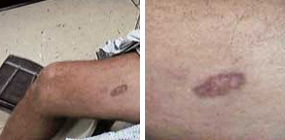This 40 year old gentleman presented with greater than a thirteen year history of lower extremity numbness beginning in both feet and ascending to his upper thighs. He first noted decreased sensation when he suffered first degree burns while repairing a water heater, and was unaware of his injury until hours later. Since that time there have been several occasions when he did not know he had burned or injured his legs. He also had involvement of his fingers with numbness beginning at the tips of his left digits and gradually spreading to his upper palm. He denied any burning, lancinating pain, but did report hypersensitivity on the plantar surface of his feet. He had subjective weakness of his hand grip and frequently dropped things, but had no difficulty with writing, or use of his work tools.

Patient #60
He denied difficulty with gait, climbing stairs, or problems with falls. He had no history of diplopia, dysphagia, visual changes, memory or cognitive impairment, bowel or bladder incontinence, sweats, fever, or weight loss.
His past medical history was unremarkable. Family history was negative for neurological diseases. His father has diabetes and mother has hypertension. He is married with two teenage children. His job entails climbing poles and repairing wires for the electric company. He has a 20 pack per year tobacco history, is a social drinker, and denies illicit/recreational drug use.

Photo of leg and close up of the skin
Physical examination was significant for healed burns on his anterior right thigh, posterior right calf, and medial surface of the left digits 2 and 3. There was absence of hair in the distal portion of legs bilaterally. Otherwise exam was within normal limits.
Mental Status: Patient was awake, alert, fully oriented. Mini mental status exam 27/30. His speech was fluent with normal comprehension and repetition. Normal lingual, labial, guttural sounds.
Cranial Nerves: Normal except for decreased sensation to pinprick more than light touch on the lower part of the face (V3) bilaterally, sparing the nose, forehead, earlobes, and chin.
Motor: Tone was normal. No muscle atrophy or fasciculations.
Strength | Right | Left |
|---|---|---|
Upper Extremities | ||
| Deltoid | 5 | 5 |
| Biceps | 5- | 5 |
| Triceps | 5 | 5 |
| Wrist Extensors | 5 | 5 |
| Wrist Flexors | 5 | 5- |
| Finger Extensors | 5 | 5 |
| Finger Flexors | 5 | 4+ |
Lower Extremities | ||
| Iliopsoas | 4+ | 5 |
| Knee Extensors | 5 | 5 |
| Knee Flexors | 4+ | 4 |
| Ankle Extensors | 5- | 5 |
| Ankle Flexors | 5 | 5 |
Reflexes: 2+ in (R) biceps, brachioradialis, and triceps; 3+ in (L) biceps, brachioradialis, and triceps; 3+ at the knees bilaterally; and 2+ at the ankles bilaterally. Negative Babinski and Hoffman; mildly positive jaw jerk.
Sensation: Decreased pinprick and temperature in the upper extremities from the fingers to mid forearm (left greater than right) and in the lower extremities from the dorsal surface of the toes to mid to upper thighs, bilaterally. Plantar surfaces of the feet slightly hypersensitive, but no evidence of significant hyperesthesia or allodynia. Light touch grossly intact, yet decreased on fine sensory exam with cotton wisp from the toes to the mid thighs. No sensory level noted. Position sense was decreased in the right lower extremity and vibration was decreased in the upper and lower extremities, distal more than proximal. Stereognosia, graphesthesia, and two-point discrimination were intact. Romberg negative.
Cerebellar: Intact finger-to-nose, heel-to-shin, and rapidly alternating movements. No loss of check or titubation noted.
Gait: Gait was steady with good heel and toe walking. Arm swing normal. Tandem intact.
Email comments: